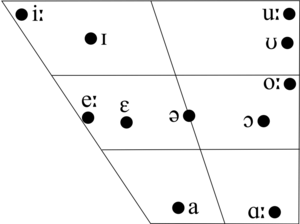Irish language: Difference between revisions
imported>John Stephenson (Northern Ireland link; subpaginating) |
imported>John Stephenson (Added a section on phonology based on an external article (Phonology of Irish) but in my own words) |
||
| Line 1: | Line 1: | ||
[[Image:Irish-speaking-areas-ireland.png|right|thumb|400px|Irish-speaking areas of [[Ireland (island)|Ireland]].]] | [[Image:Irish-speaking-areas-ireland.png|right|thumb|400px|Irish-speaking areas of [[Ireland (island)|Ireland]].]] | ||
'''Irish''' (Ir. ''Gaeilge'') is the original [[language]] of the [[Celtic people]]s of [[Ireland (state)|Ireland]]. It is a [[Celtic language]] of the [[Goidelic]] branch, and is related to [[Scots Gaelic language|Scots Gaelic]], [[Welsh language|Welsh]], [[Manx language|Manx]], [[Cornish language|Cornish]], and other early Celtic languages of the [[British Isles]]. While for many centuries it was the primary language of Ireland, and possesses a rich [[Literature|literature]], it is now the [[native speaker|natural]] (as opposed to the learned) language of only a small minority of the Irish people, primarily in the west of Ireland in a region known as the [[Gaeltacht]]. Nevertheless, it remains an [[official language]] of the Irish state; its teaching is mandated in public schools. | '''Irish''' (Ir. ''Gaeilge'') is the original [[language]] of the [[Celtic people]]s of [[Ireland (state)|Ireland]]. It is a [[Celtic language]] of the [[Goidelic]] branch, and is related to [[Scots Gaelic language|Scots Gaelic]], [[Welsh language|Welsh]], [[Manx language|Manx]], [[Cornish language|Cornish]], and other early Celtic languages of the [[British Isles]]. While for many centuries it was the primary language of Ireland, and possesses a rich [[Literature|literature]], it is now the [[native speaker|natural]] (as opposed to the learned) language of only a small minority of the Irish people, primarily in the west of Ireland in a region known as the [[Gaeltacht]]. Nevertheless, it remains an [[official language]] of the Irish state; its teaching is mandated in public schools. | ||
==Grammar== | |||
===Phonology=== | |||
[[Image:Connacht Irish vowel chart.png|thumb|The vowel phonemes of [[Connacht]] Irish.<ref>de Búrca (1958: 7).</ref>{{Connacht Irish vowel chart.png/credit}}]] | |||
[[Image:Munster Irish vowel chart.png|thumb|The vowel phonemes of [[Munster]] Irish.<ref>Ó Cuív (1944: 13).</ref>{{Munster Irish vowel chart.png/credit}}]] | |||
{{main|Phonology of Irish}} | |||
''[[Phonology]]'' here refers to the sound patterns of Irish, which vary by [[dialect]] but all share certain features. Phonologists have traditionally classified most of the language's 33 or so [[consonant]]s into 'broad' and 'slender' pairs, i.e. respectively [[velarization|velarised]] or [[palatalization|palatalised]], involving different placement of the [[tongue]]. This difference is ''[[phoneme|phonemic]]'': substituting one for another produces a different [[word]], e.g. ''bó'' 'cow' and ''beo'' 'alive'. Such consonants also affect which of Irish's 15 or so [[vowel]]s may acceptably co-occur with them. | |||
Another interesting feature of Irish phonology concerns [[consonant cluster]]s, i.e. sequences of consonants. Words may begin with two or three consonants, which usually agree in being broad or slender. Two-member clusters consist of an [[obstruent|obstruent consonant]] followed by a [[liquid|liquid consonant]] (e.g. ''pleidhce'' /ˈpʲlʲəicə/ 'idiot') or [[nasal consonant]] (e.g. ''cnaipe'' /ˈkn̪ˠapʲə/ 'button'); three-member clusters start with a [[sibilant consonant|sibilant]] such as in ''sparán'' /ˈsˠpˠaɾˠaːn̪ˠ/ 'purse', preceding a [[voicing|voiceless stop]] and a liquid.<ref>Ní Chiosáin (1999).</ref> However, under ''[[consonant mutation]]'' (changing consonants according to some rule), other sequences can occur: e.g. ''bhlas'' /wɫ̪asˠ/ 'tasted', ''mbláth'' /mˠɫ̪aː/ 'flower'.<ref>Ní Chiosáin (1999); Ó Sé (2000: 33).</ref> | |||
==Footnotes== | |||
<div class="references-2column"> | |||
<references/> | |||
</div> | |||
==References== | |||
*de Búrca S (1958) ''The Irish of Tourmakeady, Co. Mayo''. Dublin Institute for Advanced Studies. ISBN 0901282499. | |||
*Ní Chiosáin M (1999) Syllables and phonotactics in Irish. In van der Hulst H & Ritter NA ''The syllable: Views and Facts''. Berlin: Mouton de Gruyter. pp.551–575. ISBN 3110162741. | |||
*Ó Cuív B (1944) 'The Irish of West Muskerry, Co. Cork'. Dublin Institute for Advanced Studies. ISBN 0901282529. | |||
*Ó Sé D (2000) 'Gaeilge Chorca Dhuibhne'. Dublin: Institiúid Teangeolaíochta Éireann. ISBN 0946452970. | |||
==See also== | ==See also== | ||
Revision as of 23:58, 7 October 2007
Irish (Ir. Gaeilge) is the original language of the Celtic peoples of Ireland. It is a Celtic language of the Goidelic branch, and is related to Scots Gaelic, Welsh, Manx, Cornish, and other early Celtic languages of the British Isles. While for many centuries it was the primary language of Ireland, and possesses a rich literature, it is now the natural (as opposed to the learned) language of only a small minority of the Irish people, primarily in the west of Ireland in a region known as the Gaeltacht. Nevertheless, it remains an official language of the Irish state; its teaching is mandated in public schools.
Grammar
Phonology
Phonology here refers to the sound patterns of Irish, which vary by dialect but all share certain features. Phonologists have traditionally classified most of the language's 33 or so consonants into 'broad' and 'slender' pairs, i.e. respectively velarised or palatalised, involving different placement of the tongue. This difference is phonemic: substituting one for another produces a different word, e.g. bó 'cow' and beo 'alive'. Such consonants also affect which of Irish's 15 or so vowels may acceptably co-occur with them.
Another interesting feature of Irish phonology concerns consonant clusters, i.e. sequences of consonants. Words may begin with two or three consonants, which usually agree in being broad or slender. Two-member clusters consist of an obstruent consonant followed by a liquid consonant (e.g. pleidhce /ˈpʲlʲəicə/ 'idiot') or nasal consonant (e.g. cnaipe /ˈkn̪ˠapʲə/ 'button'); three-member clusters start with a sibilant such as in sparán /ˈsˠpˠaɾˠaːn̪ˠ/ 'purse', preceding a voiceless stop and a liquid.[3] However, under consonant mutation (changing consonants according to some rule), other sequences can occur: e.g. bhlas /wɫ̪asˠ/ 'tasted', mbláth /mˠɫ̪aː/ 'flower'.[4]
Footnotes
References
- de Búrca S (1958) The Irish of Tourmakeady, Co. Mayo. Dublin Institute for Advanced Studies. ISBN 0901282499.
- Ní Chiosáin M (1999) Syllables and phonotactics in Irish. In van der Hulst H & Ritter NA The syllable: Views and Facts. Berlin: Mouton de Gruyter. pp.551–575. ISBN 3110162741.
- Ó Cuív B (1944) 'The Irish of West Muskerry, Co. Cork'. Dublin Institute for Advanced Studies. ISBN 0901282529.
- Ó Sé D (2000) 'Gaeilge Chorca Dhuibhne'. Dublin: Institiúid Teangeolaíochta Éireann. ISBN 0946452970.
